Farming carbon
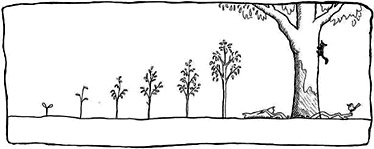

Potential to store carbon
- It is estimated that there are between 41 and 113 tonnes per hectare of above-ground biomass in eucalypt woodlands (that are at least 25 years old) which translate to about 70 to 195 tonnes of carbon dioxide equivalent.
- Above-ground carbon in eucalypt woodland is stored in living trees and shrubs, and also in dead standing trees, fallen timber and litter.
- The estimated peak carbon accumulation rate of reforestation in eucalypt woodland country ranges from about 1 to more than 3 tonnes of carbon dioxide equivalents per hectare per year. This peak is expected to occur when the woodland is between 10 and 20 years old.
Carbon farming might not always mean bringing eucalypt woodland country back to its full carbon capacity as soon as possible. Some carbon returns might be traded off against other land uses, such as livestock grazing, which may limit carbon accumulation rates. Low to moderate levels of livestock grazing appear to be compatible with reforestation in eucalypt woodland country.
Note: to generate carbon credits you will need to register a project with the Clean Energy Regulator using an approved method. The methods detail the conditions or rules for generating carbon credits (Australian Carbon Credit Units) and how vegetation is to be managed as part of a project.
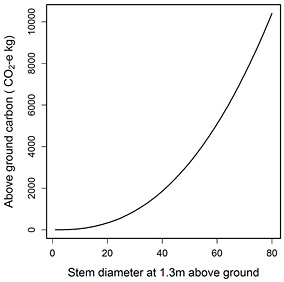

Carbon storage and tree size
Large trees hold far more carbon than small trees because the amount of carbon held increases exponentially as the trunk diameter of a tree increases (see graph to right). For example, the carbon held in an average very large tree (e.g. 60cm trunk diameter) is approximately equivalent to that held in nearly 500 smaller trees (e.g. 5cm trunk diameters – see diagram).
| Tree dbh (cm) | Dry matter (kg) | Carbon (kg) | CO2 equivalent (kg) |
|---|---|---|---|
| 5 | 5 | 3 | 10 |
| 30 | 458 | 215 | 790 |
| 60 | 2565 | 1206 | 4424 |
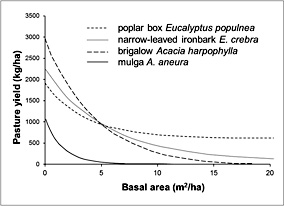

Trade-offs between trees and pasture
Increasing the basal area of trees in grassy woodlands tends to result in decreased pasture yield. This has been observed for a variety of woodland types in Queensland, including eucalypt woodlands.
It may be possible to combine carbon farming of regrowth with livestock production, but landholders should consider how increased tree growth may impact on their pasture yield.
Relationships between tree basal area and pasture yield for a range of woodland tree species from sites in Queensland. Drawn based on compilation of research by Burrows (2002); data originally derived from Beale 1973 for mulga (A. aneura), Scanlan and Burrows (1990) for E. populnea and E. crebra, and Scanlan (1991) for A. harpophylla (see Eucalypt woodlands Management Guideline (PDF, 1.69MB) for details).
Grow big trees to maximise carbon
A few big trees can hold far more carbon than a large number of small or medium trees. So it is in the interests of carbon farming to maximise the height and diameter of existing trees, which may be achieved by reducing tree density in dense regrowth. This may involve the selective thinning of smaller trees, or allowing drought and competition among trees to result in natural rates of tree dieback and thinning. The biomass in dead trees will decay slowly but will continue to act as a carbon store for some time. Before undertaking any thinning, landholders should check whether such treatment is permitted under the methodology they are using for their carbon farming project.
Increasing tree basal area is still likely to reduce pasture yield, but a few large trees will hold far more carbon than many small ones, for the same basal area. The retention of some trees has also been found to improve pasture quality due to inputs of nutrients and faster water infiltration under tree canopies, than when trees are absent.
The combination of trees with pasture is likely to provide multiple benefits for carbon accumulation, pasture quality and soil health.
Retaining fewer, larger trees (rather than dense thickets of small trees) will maximise carbon, result in optimal pasture for grazing, and provide added benefits of microclimate changes, shade and shelter for livestock.
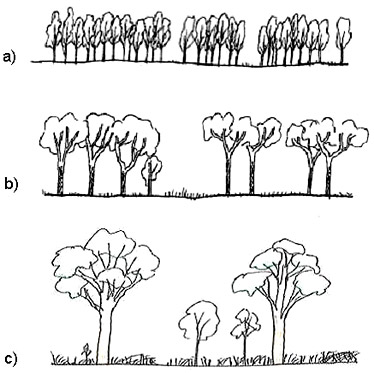

| Tree dbh (cm) | Number of trees | Basal area (m2) | CO2 equivalent (kg) | |
|---|---|---|---|---|
| (a) | 5 | 1528 | 3 | 14,821 |
| (b) | 30 | 42 | 3 | 33,529 |
| (c) | 60 | 11 | 3 | 46,940 |
Limits to carbon accumulation
Carbon accumulation in eucalypt woodland is limited by rainfall, clearing, soil degradation, fire, and grazing pressure.
The total amount of carbon stored by eucalypt woodland, and the rate it accumulates, can be maximised by removing these limits where possible.
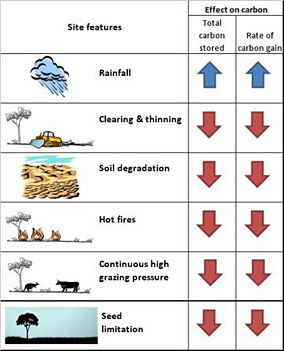

Rainfall
Water is a critical resource for plant establishment and growth in woodlands.
Many woodland eucalypts only establish significant numbers of new seedlings during runs of wet years, a few times each century.
Extended drought will certainly slow growth and may also cause the dieback and/or death of mature trees. Therefore reduced rainfall has the potential to limit both the amount of carbon stored, and its rate of accumulation.
Clearing and thinning
Clearing trees and shrubs in eucalypt woodlands will reduce the rate of carbon gain, decrease the capacity of the vegetation to store carbon, and produce an overall carbon loss.
Thinning trees and shrubs will also reduce carbon stores. But careful thinning of canopy trees when stem densities are high may also help the growth of the remaining trees, and this may increase the amount of carbon stored in the long term.
Soil degradation
Soil degradation, (when soil is compacted and/or eroded) can reduce or prevent the establishment and growth of eucalypts, and this limits carbon storage and accumulation rates.
Hot fires
Fires of moderate or higher severity can kill trees, and will release the carbon in trees, shrubs, dead wood and litter. This reduces carbon stores and slows the rate of carbon accumulation.
Continuous high grazing pressure
Some grazing is ok for reforestation in eucalypt woodland country as long as it does not affect tree establishment and growth, or affect the quality of the soil.
Continuous high grazing pressure is not recommended, but strategic grazing management that reduces fire risk, and allows tree recruitment when rainfall is adequate, is likely to maximise carbon storage and accumulation rates.
More information is needed to determine grazing regimes (including timing and stocking rates) that will allow the optimum production of trees.
Seed limitation
Most seeds of woodland eucalypts fall at a distance within 2 or 3 times the height of the parent tree.
This means that in many sites, reforestation will be limited by seed supply or highly patchy around seed sources, and this can limit the amount and rate of carbon that is accumulated. However, seed collection and direct seeding can be used to improve seedling establishment in many situations.


